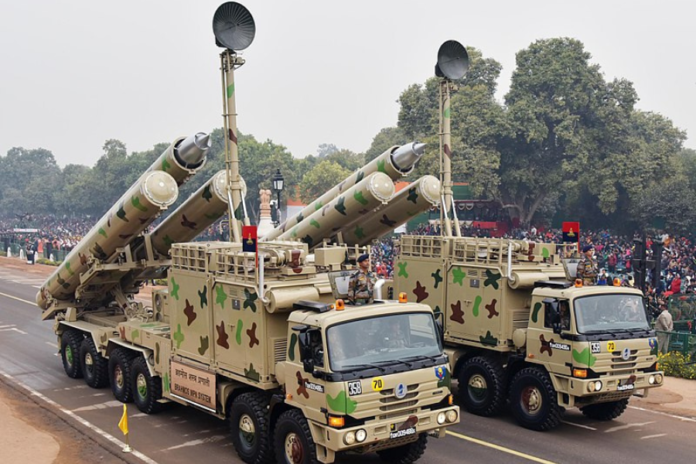The Indian defence establishment spent the night of March 9, 2022, in the dark and with the utmost caution. After all, a BrahMos supersonic cruise missile produced by India accidentally launched and made landfall in an uninhabited area inside Pakistan.
The Indian defence establishment must have been thrilled that the supersonic cruise missile, frequently referred to as the Indian “Brahmastra,” was able to avoid Pakistani radars, in addition to the fact that the two nuclear-armed nations avoided war.
BrahMos missile stumps Pakistan
On March 9, at around 7 p.m., a BrahMos missile was launched from a location close to Ambala and landed 124 kilometres away in Mian Channu in the Punjab region of Pakistan. There were no warheads on the nuclear-capable ground strike missile.
A “supersonic projectile” was said to have been launched from an Indian Air Force (IAF) base in Sirsa, in the North India state of Haryana, according to Pakistan. However, despite the alleged tracking, Pakistan was unable to intercept the missile.
One of the few cruise missiles in existence that can travel at high supersonic speeds is the BrahMos. The BrahMos missile is extremely challenging to engage or avoid due to its speed. The missile is also far more lethal than subsonic cruise missiles due to its incredible speed.
Pakistan attempted to infiltrate DRDO missile program
Although the event gave Pakistani forensic specialists the chance to get their hands on one of India’s most powerful weapons, it appears Pakistan has increased its efforts to disassemble the missile.
The prominent Indian scientist Pradeep Kurulkar was “honey trapped” by a Pakistani spy who pretended to be “Zara Dasgupta” and spoke extensively about BrahMos, also known as “the dangerous one.”
The 59-year-old Kurulkar was detained on May 3 by the Maharashtra ATS under sections of the Official Secrets Act (OSA) related to spying and improper communication with the female Pakistan Intelligence Operative (PIO). Kurulkar is the head of the DRDO’s Research and Development Establishment (Engineers) or R&D (E) laboratory.
From October 19 until October 28, 2022, the two people talked only about BrahMos.
According to an Indian Express report, Zara asked Kurulkar: “Brahmos was also your invention, babe…. The dangerous one.”
“I have an initial design report of some 186 A4 size pages on all BrahMos versions,” Kurulkar reportedly replied.
Later, Kurulkar allegedly told her, “I cannot send a copy of that report to WA or mail. It is highly classified… I will trace and keep it ready when you are here. Will try and show you here.”
The Anti-Terrorism Squad (ATS) of Maharastra filed a chargesheet that spans six volumes and 1,837 pages. The ATS received WhatsApp chats between the two people during the inquiry.
Kurulkar and Zara had WhatsApp conversations about the DRDO’s “Agni 6,” “Unmanned Combat Air Vehicles (UCAV),” “Drone projects,” and “Rustom (a medium-altitude, long-endurance unmanned air vehicle),” according to the chargesheet.
Additionally, there are discussions on the “Quadcopter, DRDO duty chart, Meteor missile, Rafael, Akash, and Astra missile.” It speaks about a DRDO vendor who works for a private Indian defence firm and produces “robotic equipment” for the country’s armed forces.
Pakistan has no answer for BrahMos
The alleged misfiring incident did damage Pakistan’s ability to defend against air attacks. Why Pakistan did not respond to the hostile projectile has been questioned.
The inability of Pakistan’s air defence to track the supersonic cruise missile in flight is highlighted by experts. Incorporated into the military in 2021, the most recent air defence system in Pakistan’s arsenal is a surface-to-air missile (SAM) system produced in China called the HQ-9.
The HQ-9/P has a high “single shot kill probability” and a range of over 100 kilometres against cruise missiles and aircraft, according to Inter-Services Public Relations (ISPR), the propaganda arm of the Pakistani Armed Forces. The required radar cross-section, according to Janes, is unknown, and this range is believed to only be effective against aircraft. Engagement ranges are thought to be substantially shorter—around 25 km—against cruise missiles and other similar targets.
BrahMos: A formidable weapon
BrahMos has advanced significantly since its initial testing in 2001. Since then, the BrahMos manufacturer has succeeded in integrating the missile with the Sukhoi Su-30MKI fighter jets, extended its range from 290 kilometres to 450 kilometres, and developed a naval variant that can be fired from stealth destroyers. Therefore, BrahMos can be shot from the ground, the air, or the water.
The Indian Air Force (IAF) is currently looking for a smaller, more stealthy variant of the missile that may be installed in indigenously made Light Combat Aircraft (‘Tejas’) and smaller MiG-29 warplanes.
One of the worst attacks on the port cities of Odesa in July demonstrated the strength of BrahMos. With its powerful missiles, including at least seven Oniks (or Onyx) missiles, Russia struck the city hard. None of the P-800 Oniks missiles, on which BrahMos is based, were downed, according to the EurAsian Times.
With a speed of Mach 2.5, the P-800 Oniks is a high-supersonic anti-ship missile that is frequently utilised against land targets in Ukraine. The Oniks missile is infamous for taking predefined paths and having the capacity to get past an opponent’s air defences.
It contains cutting-edge features including a “fire-and-forget” guiding system to give this extra bite.
The Indian BrahMos missile is an offshoot of the Russian P-800 Oniks and Yakhont missile family and was developed by the Indo-Russian joint venture BrahMos Aerospace. The P-800 Onyx’s outstanding performance during the Ukraine War must have given the Indian military confidence in the ‘invincible’ BrahMos.



